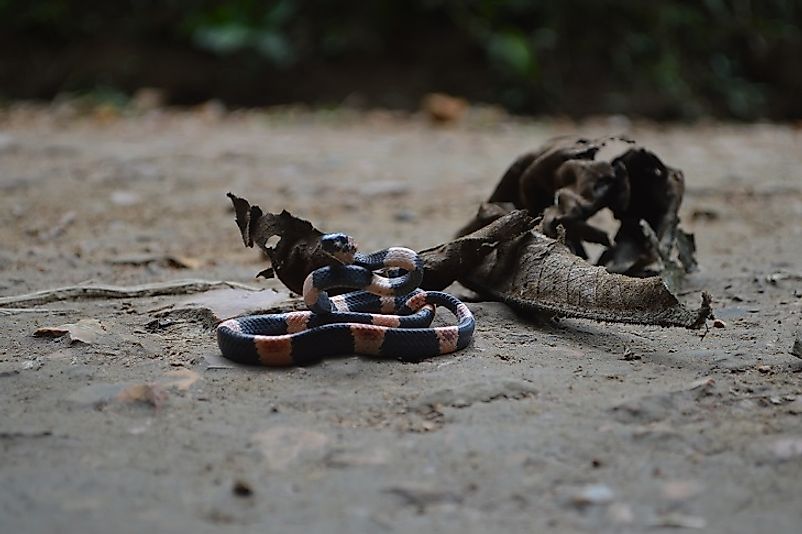Native Reptiles Of Peru

Peru's rainforests are world famous for their populations of large, constricting, and/or venomous snakes. The country has a wide variety of reptiles ranging from around 300 species of which around 100 are endemic. Most of these reptiles are found on the eastern side of the country in the Amazon rainforest where the temperatures are humid and warm thus providing good conditions for reproduction. The warm temperatures are also important in regulating the body temperatures of these ectothermic animals. These reptiles include snakes, turtles, and lizards. Some of these reptiles are exploited as pets while others are dominant in the wild.
Tschudii Skink (Trachylepis tschudii)
This skink is a rare enigmatic species native to the Amazon forest regions of Peru. The reptile has a snout to vent length of 3.3 inches. The skink is insectivorous mainly feeding on flies, crickets, grasshoppers and beetles. The skink burrows in the ground for shelter from predators. They are primarily preyed upon by raccoons, foxes, cats, dogs, snakes, and possums. Their scales are rough though their skins are superficially smooth. Like other reptiles in Peru, the main threat to this species is habitat destruction and fragmentation.
Eyelash Viper (Bothriechis schlegelii)
The eyelash viper is a venomous pit viper found in Central and South America, including the humid tropical areas of Peru. The small and arboreal snake has a wide variation of color and superciliary scales above the eyes that look like eyelashes. Adults of these species have a body length of 22 to 32 inches, with females being larger and more variable in size than the males. Their head is broad and triangular shaped with eyes that have a vertical pupil. Fangs are located on the upper jaw and fold when not in use. The eyelash viper is mainly found in areas with dense foliage that is close to water sources. This nocturnal viper feeds on rodents, frogs, lizards, and small birds. The Viper is at risk due to habitat loss due to unsustainable land use methods. Fertilization is internal with a gestation of six months with between 2 and 20 young ones.
Lima Gecko (Phyllodactylus sentosus)
The Lima gecko is a critically endangered rare endemic species mainly found in and around the archaeological sites near the major city of Lima in Peru. The species is isolated therefore reproduction is within among related individuals making them weak and unable to withstand adverse climatic conditions. The gecko feeds on flies, beetles, and spiders. The natural habitat of the gecko is coastal deserts in areas with substrate dry soil or sand with some rocks. This terrestrial reptile reproduces by laying eggs.
Graceful Snail Eater (Dipsas gracilis)
The graceful snail eater is a widely distributed snake found in Peru, Colombia, and Ecuador. The snake is nocturnal and forages for snails and slugs in low vegetation. The snake is docile and is completely harmless but emits an unpleasant odor when threatened. The habitats of this snake have been destroyed due to deforestation.
Conservation of Peruvian Reptiles
A number of notable conservation efforts have been made towards conserving and protecting these and other species of Peruvian reptilian fauna. Such efforts have included the setting up of protected areas to conserve these species. Other reptiles found in Peru include the Coastal Leaf-Toed Gecko, the Emerald Tree Boa, the Giant Ameiva, the False Coral Snake, the White-Lipped Mud Turtle, and the Green Anaconda.
Native Reptiles Of Peru
| Native Reptiles of Peru | Scientific Name |
|---|---|
| Tschudii Skink | Trachylepis tschudii |
| Eyelash Viper | Bothriechis schlegelii |
| Lima Gecko | Phyllodactylus sentosus |
| Graceful Snail-Eater | Dipsas gracilis |
| Coastal Leaf-Toed Gecko | Phyllodactylus kofordi |
| Emerald Tree Boa | Corallus caninus |
| Giant Ameiva | Ameiva ameiva |
| False Coral | Erythrolamprus aesculapii |
| White-Lipped Mud Turtle | Kinosternon leucostomum |
| Green Anaconda | Eunectes murinus |







